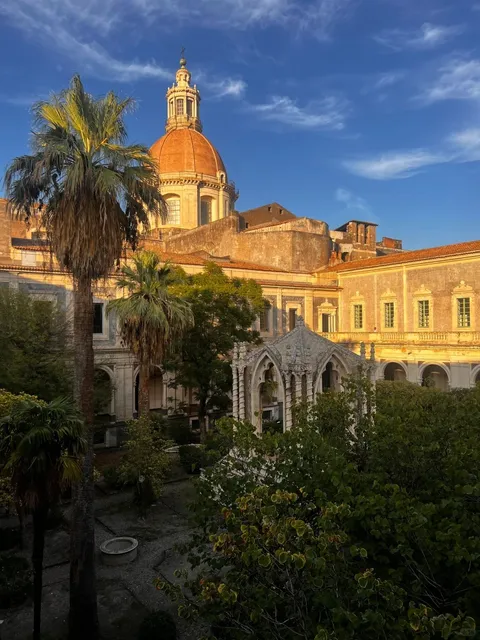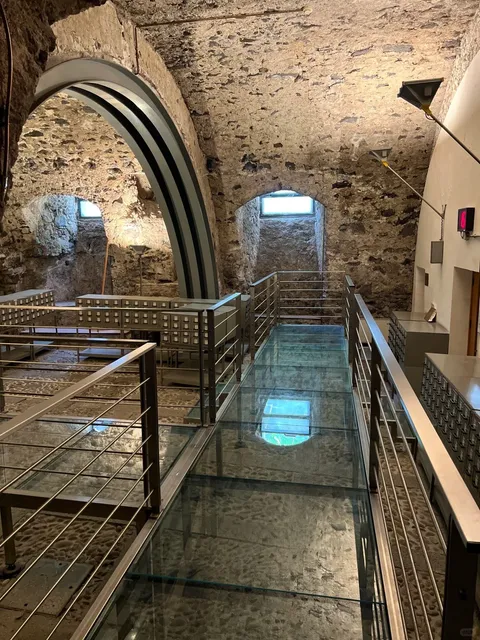One of the biggest monastery’s in Europe and the pearl of Sicilian late baroque style which was included to UNESCO world heritage list. Now there is a Humanitarian faculty of the Catania University. From the top of the church in university there is a panoramic view on the city and volcano Etna. The monastery was founded in 1558 by Casino monks, firstly it was created in a square shape with an internal cloister defined as “Marbles”, ( 17 th century colonnade, fountain and decorations from Carrara marble). After eruption of Etna in 1669 the monastery was saved but the church attached to it was destroyed. But the catastrophic earthquake in 1693 destroyed almost everything. The basement and parting the first floor of the 16th century monastery remain intact. Of the cloister, 14 columns remain erect, the others fall down and break. In 1702 reconstruction began and the monastery was repopulated by monks coming from other monasteries. The monastery grew compared to the original plan. Next to the ‘Marble’ or Western cloister, rebuilt and renewed with late-baroque decorations, the Eastern Cloister with its garden and the Caffeaos in eclectic style was added. A new area on the North side was also added to host the rooms destined to the common activities of the monks: the library, the kitchen, the novices’ aisle, the dining rooms, the night choir (chapel). On top of the lava ‘wall’, were built two gardens: the botanical garden – the wonders garden – and the novices’ garden. The facade of the of the San Nicolò l’Arena church is unfinished. Extended and enriched with decorations, the monastery became one of the biggest in Europe.
Various famous Sicilian architects took part in the reconstruction: Ittar, Battaglia, Battaglia Santangelo, and Palazzotto. Giovan Battista Vaccarini who participated in the reconstruction: he designed the kitchen, the main dining-hall and the library.
In 1866, the state confiscated the Benedictine Monastery and from 1868 the monastery was re-used for civil scopes.
I could not even imagine what is the happiness to study in such historical walls of...
Read moreBest attraction in Catania! It's still called a monastery, but today it's the house of the University of Catania, Faculty of Humanities, home to 900 lucky students. The monastery, 3rd in size in Europe, was built by 50 opulent rich monks, who wanted to live a flourishing life. The building went through a lava eruption event in 1669, and a huge devastating earthquake in 1693. The monks used the opportunity to rebuild it 15 times bigger. The university discovered lots of rooms and architectural treasures such as a mosaic floor of an Ancient Roman house, and an even older Greek house structure, on which the monks built the monastery, or the fountain which had also been lost at some point, and just rebuilt in 2007 using a sketch made by a French architect that the university managed to find in Paris. The current library is located in the old celler underneath the monastery, and above the ancient Roman and Greek findings. It's amazing that the students have access to such precious surroundings every day, and it's due to the University's culture and values, believing that such treasures must be shared, enjoyed and cherished (as opposed to most universities located in historical buldings where students only have access to the modern parts, while the historical parts house the offices). The headmaster's office is also an amazing historical room, and if you visit during the weekend, you get to see it too. The monastery may be visited only with a guided tour, there's several groups daily both in Italian and English, everything available on their website. It costs 10 EUR and it's worth every penny. You get to visit everything and learn its amazing story from a super nice, charming and passionate guide. ♥️ Buy the tickets in advance, especially for the English tour, as it's usually fully...
Read moreIf you're looking for a unique and fascinating experience in Catania, look no further than the Monastero dei Benedettini di San Nicolò l'Arena. This ancient monastery has been through it all, surviving earthquakes, lava flows from Mount Etna, and even being repurposed over the years as a gym, school, barracks, and university. Yet, even after all of that, it still stands tall and proud in the heart of Catania.
I highly recommend taking a guided tour of the monastery to truly appreciate its history and significance. For just €8 per person, you'll receive a 70-minute tour that will take you through each hall and help you understand the story behind it. From the different gardens and their meanings to the underground area and kitchen, you'll get a glimpse into the past and how the monks lived.
Overall, the Monastero dei Benedettini di San Nicolò l'Arena is definitely worth visiting. Don't hesitate, step in and touch the history of this...
Read more

